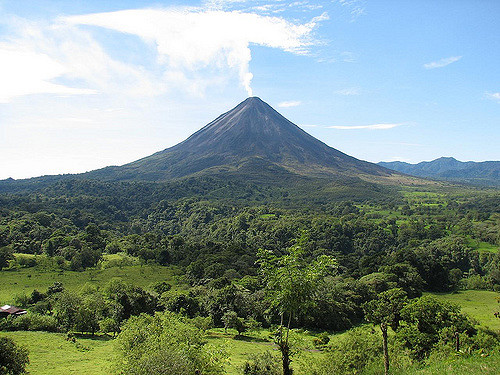When gases, volcanic ash and lava rupture from beneath a magma chamber below the Earth’s crust, 17 tectonic plates float in the planet’s mantle and eventually form a volcano. For this reason, most of the volcanoes in the world are locate where tectonic plates converge or diverge, or where crust plates stretch and thin. Interestingly, most volcanoes are under water. Volcanoes that erupt regularly are considered active. If a volcano erupted in historical times but is now quiet, it is dormant, or inactive. Extinct volcanoes are those that have not erupted in historical times, such Kohala in Hawaii. When flying to a destination in a private jet to see a volcano, it is a good idea to verify that conditions are safe enough for visitors.
Stunning Volcanoes to Add to Your Travel Wish List
Volcán Arenal, Costa Rica
Popular among geologists for being hyperactive from 1968 to 2010, Arenal’s activity in the Costa Rican rainforest has calmed down a bit. However, it is still known to spurt out lava and ash. While climbing to Arenal’s summit is not permitted, there are hiking trails over old lava flows on the mountain that rewards you with encounters with monkeys, toucans, bright flowers and other tropical wildlife. If you sit quietly in the viewing areas, you’ll hear the volcano breathe.
Poás is another popular volcano in the Latin American country. Because it’s dormant, visitors are allowed to trek to its summit.
Eyjafjallajökull, Iceland
With one of the smaller ice caps in Iceland, Eyjafjallajökull last erupted in 2010. If you’re up for a challenging, long hike through a scenic landscape of snow, ash and ice that begins at sea level, the top of the glacier will amaze you with a giant crater. On clear days, you’ll find yourself breathless—not from the hike, but from the view of half the country and its glaciers and other volcanoes. The best time to visit is between April and September because the days are longer.
Mælifell on the Mýrdalsjökull glacier is another wonderful volcano that’s known for its perfectly-shaped cone, black soil, moss-covered surface and surreal landscape.
Pinatubo, Luzon, Philippines
Last erupting in 1991, Pinatubo produced one of the most brutal eruptions in the 20th century. Since then, the volcano has calmed down and now dazzles visitors with a beautiful turquoise crater lake. The best time of year to charter a flight to see Pinatubo is in January when temperatures are cooler. Hire a tour company to take you up part of the summit in a 4-by-4. Then hike for a few hours up a moderate incline, past sandy cliffs and tribes of indigenous people.
Mount Stromboli, Aeolian Islands
For a more exclusive adventure, fly to Sicily’s north coast, to a small island in the Tyrrhenian Sea. Mount Stromboli is known for its regular yet small explosions that launch glowing lava into the air. With Stromboli in continuous eruption for the past 2,000 years, only a handful of hikers are permitted to visit Stromboli’s three craters annually. And, only those with guides may attempt to reach its summit, a hike that isn’t for the faint of heart. Opt for an evening hike to see the light show the volcano produces as its craters shoot red sparks into the air. If this seems too close for comfort, charter a yacht to try your luck at watching the show from a distance.
Mount St. Helens, Washington State
Known for its flat top, the ash from Mount St. Helens drifted around the globe within two weeks of its 1980 eruption, which was one of the deadliest and most economically destructive volcanic events in U.S. history. Hiking the mountain to reach its summit requires a coveted permit, and park staff members only hand out a limited number annually. The climb is best for more experienced hikers because of hazards like unpredictable weather, ice, and loose boulders. When you finally reach the top, you’ll find the view nothing less than inspiring as you gaze upon Mt. Hood, Mt. Adams and Mt. Rainier.

“A 4×4 vehicle carrying trekkers near the Mount Pinatubo crater kicks up dust as it traverses a path covered with volcanic ash in Zambales, Philippines.” -Photo by Reginald Pentinio

